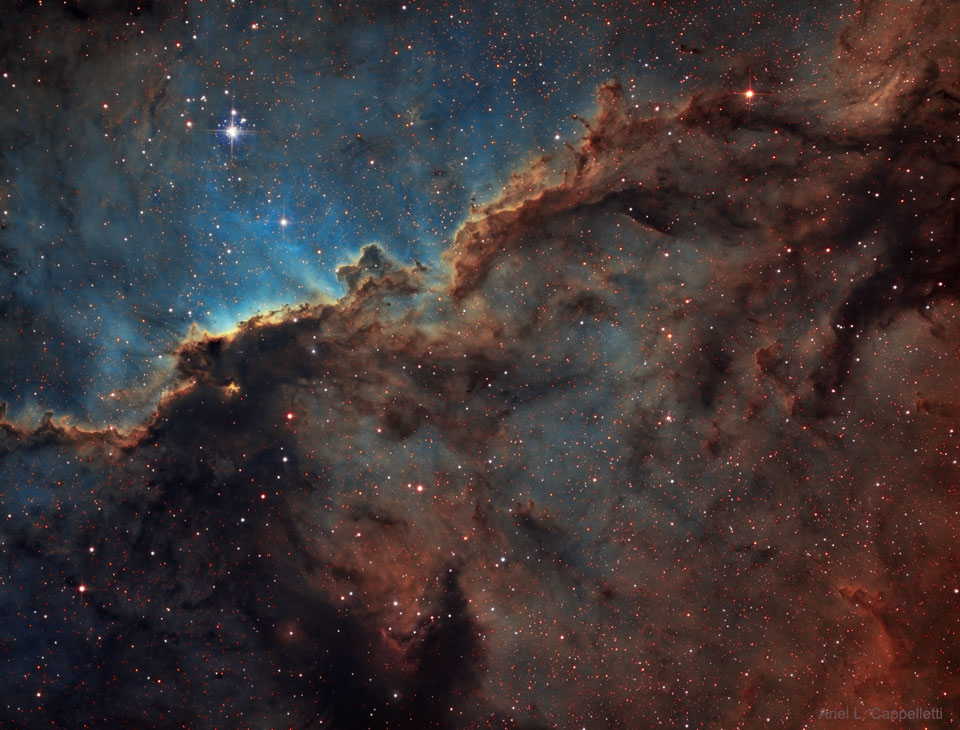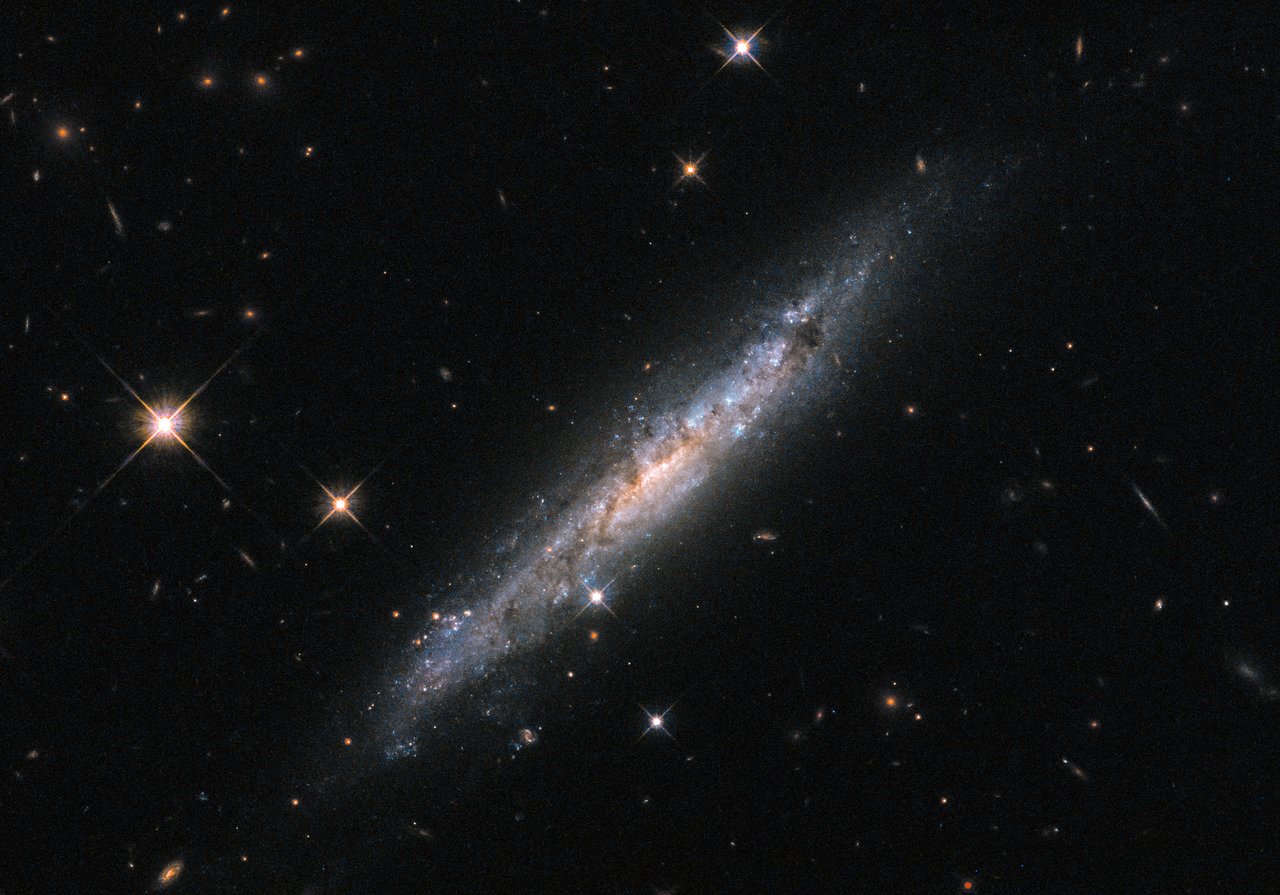Blog
https://www.youtube.com/watch?v=rGJcbHni4rc
more...NGC 6188 are tens of light-years long. The emission nebula is found near the edge of an otherwise dark and large molecular cloud in the southern constellation Ara, about 4,000 light-years away. Born in that region only a few million years ago, the massive young stars of the embedded Ara OB1 association sculpt the fantastic shapes and power the nebular glow with stellar winds and intense ultraviolet radiation. The recent star formation itself was likely triggered by winds and supernova explosions, from previous generations of massive stars, that swept up and compressed the molecular gas. The featured image accumulated over 10 hours through a backyard telescope in Córdoba, Argentina and was false-colored using the Hubble palette highlighting emission from sulfur, hydrogen, and oxygen atoms in red, green, and blue hues. The field of view spans about four full Moons, corresponding to about 150 light years at the estimated distance of NGC 6188.

Delfeayo Marsalis (/ˈdɛl fiː oʊ/; born July 28, 1965) is an American jazz trombonist, record producer and educator.
Marsalis was born in New Orleans, the son of Dolores (née Ferdinand) and Ellis Louis Marsalis, Jr., a pianist and music professor. He is also the grandson of Ellis Marsalis, Sr., and the brother of Wynton Marsalis (trumpeter), Branford Marsalis (saxophonist), and Jason Marsalis (drummer). Delfeayo also has two brothers who are not musicians: Ellis Marsalis III (b. 1964) is a poet, photographer and computer networking specialist based in Baltimore, and Mboya Kenyatta (b. 1970) is autistic and was the primary inspiration for Delfeayo’s founding of the New Orleans-based Uptown Music Theatre. Formed in 2000, UMT has trained over 300 youth and staged eight original musicals, all of which are based upon the mission of “community unity”.
more...Michael Bernard Bloomfield (July 28, 1943 – February 15, 1981) was an American guitarist and composer, born in Chicago, Illinois, who became one of the first popular music superstars of the 1960s to earn his reputation almost entirely on his instrumental prowess, since he rarely sang before 1969. Respected for his guitar playing, Bloomfield knew and played with many of Chicago’s blues musicians before achieving his own fame and was instrumental in popularizing blues music in the mid-1960s. He was ranked No. 22 on Rolling Stone‘s list of “100 Greatest Guitarists of All Time” in 2003 and No. 42 by the same magazine in 2011. He was inducted into the Blues Hall of Fame in 2012 and, as a member of the Paul Butterfield Blues Band, was inducted into the Rock and Roll Hall of Fame in 2015.
Bloomfield was born into a wealthy Chicago Jewish-American family. Bloomfield’s father, Harold Bloomfield, was born in Chicago in 1914. After pursuing business ventures in California during the 1920s, he returned to the city in the early 1930s. Harold Bloomfield began manufacturing restaurant supplies, and by the latter part of the decade his company, Bloomfield Industries, was making pie cases, kitchen utensils, salt and pepper shakers, and sugar pourers. By the early 1940s Bloomfield Industries had acquired more manufacturing and warehouse space. The company expanded during World War II by manufacturing supplies needed for the war effort. Working with his brother, Daniel, and his father, Samuel, Harold Bloomfield built up Bloomfield Industries into a thriving business. Michael Bloomfield’s mother was born Dorothy Klein in Chicago in 1918 and married Harold Bloomfield in 1940. She came from an artistic, musical family, and worked as an actor and a model before marrying Bloomfield.
more...Jimmy “Duck” Holmes (born July 28, 1947) is an American blues musician and proprietor of the Blue Front Cafe on the Mississippi Blues Trail, the oldest surviving juke joint in Mississippi. Holmes is known as the last of the Bentonia bluesmen, as he is the last blues musician to play the Bentonia School. Like Skip James and Jack Owens and other blues musicians from Bentonia, Mississippi, Holmes learned to play the blues from Henry Stuckey, the originator of the Bentonia blues. Holmes’ music is based in the Bentonia tuning utilizing open E-minor, open D-minor and a down tuned variant, and is noted for its haunting, ethereal, rhythmic and hypnotic qualities. His eighth album, It Is What It Is, on Blue Front Records has been praised by fans and music critics who have called it: “addictive” and “obsession worthy,” “as gritty, stark and raw as one could imagine” and “absolutely hypnotic,” and “an essential modern recording.”
Jimmy Charles Holmes was born in Yazoo County, Mississippi, United States, to Carey and Mary Holmes at their home in Bentonia, Mississippi. Holmes’ parents were sharecroppers, who opened the Blue Front Cafe in 1948, the year after he was born. They had ten children, but also raised four grandchildren when one of their daughters died.
more...David “Junior” Kimbrough (July 28, 1930 – January 17, 1998) was an American blues musician. His best-known works are “Keep Your Hands off Her” and “All Night Long”.
Kimbrough was born in Hudsonville, Mississippi, and lived in the north Mississippi hill country near Holly Springs. His father, a barber, played the guitar, and Junior picked his guitar as a child. He was apparently influenced by the guitarists Lightnin’ Hopkins, Mississippi Fred McDowell and Eli Green (who had a reputation as a dangerous voodoo man).
In the late 1950s Kimbrough began playing the guitar in his own style, using mid-tempo rhythms and a steady drone played with his thumb on the bass strings. This style would later be cited as a prime example of hill country blues. His music is characterized by the tricky syncopation between his droning bass strings and his midrange melodies. His soloing style has been described as modal and features languorous runs in the middle and upper registers. The result was described by music critic Robert Palmer as “hypnotic”. In solo and ensemble settings it is often polyrhythmic, which links it to the music of Africa. North Mississippi bluesman and former Kimbrough bassist Eric Deaton suggested similarities between Kimbrough’s music and that of Fulani musicians such as Ali Farka Touré. The music journalist Tony Russell wrote that “his raw, repetitive style suggests an archaic forebear of John Lee Hooker, a character his music shares with that of fellow North Mississippian R. L. Burnside“.
In 1966 Kimbrough traveled to Memphis, Tennessee, to record for Goldwax Records, owned by the R&B and gospel producer Quinton Claunch. Claunch was a founder of Hi Records and is known as the man who gave James Carr and O.V. Wright their starts. Kimbrough recorded one session at American Studios. Claunch declined to release the recordings, deeming them too country. Some forty years later, Bruce Watson, of Big Legal Mess Records, approached Claunch to buy the original master tapes and the rights to release the recordings made that day. These songs were released by Big Legal Mess Records in 2009 as First Recordings.
more...Charles Reed “Charlie” Biddle, CM (July 28, 1926 – February 5, 2003) was an American-Canadian jazz bassist. He lived most of his life in Montreal, organizing and performing in jazz music events.
Biddle was born and grew up in West Philadelphia. He served in the United States Armed Forces during World War II, serving in China, India and Burma. After the war, he studied music at Temple University in Philadelphia, where he started playing bass.
In 1948, Biddle arrived in Montreal while touring with Vernon Isaac’s Three Jacks and a Jill. Biddle was impressed by the fact that in Canada, particularly Quebec, black jazz musicians often played alongside white jazz musicians as friends and bandmates. He decided to settle down in Montreal, and fell in love with a French-Canadian woman, Constance. The two eventually married and raised three daughters – Sonya, Stephanie and Tracy – and a son, Charles Biddle Jr.
Biddle was employed as a car salesman from 1954 to 1972, while performing with pianists Charlie Ramsey, Milt Sealey, Alfie Wade, Sadik Hakim, and Stan Patrick in local Montreal nightclubs. He became a promoter, and booked musicians Johnny Hodges, John Coltrane, Pepper Adams, Bill Evans, Art Farmer, Tommy Flanagan and Thad Jones to perform in Montreal. He performed occasionally with guitarist Nelson Symonds between 1959 and 1978. Between 1961 and 1963 the pair performed together under Biddle’s leadership at Dunn’s and La Tête de l’Art, and under Symonds’ leadership at the Black Bottom from 1964 to 1968. As a duo they performed at several resort communities in the Laurentians between 1974 and 1978.
more...ESO 580-49, may seem tranquil and unassuming, but this spiral galaxy actually displays some explosive tendencies.
In October of 2011, a cataclysmic burst of high-energy gamma-ray radiation — known as a gamma-ray burst, or GRB — was detected coming from the region of sky containing ESO 580-49. Astronomers believe that the galaxy was the host of the GRB, given that the chance of a coincidental alignment between the two is roughly 1 in 10 million. At a distance of around 185 million light-years from Earth, it was the second-closest gamma-ray burst(GRB) ever detected.
Gamma-ray bursts are among the brightest events in the cosmos, occasionally outshining the combined gamma-ray output of the entire observable Universe for a few seconds. The exact cause of the GRB that probably occurred within this galaxy, catalogued as GRB 111005A, remains a mystery. Several events are known to lead to GRBs, but none of these explanations appear to fit the bill in this case. Astronomers have therefore suggested that ESO 580-49 hosted a new type of GRB explosion — one that has not yet been characterised.

Jean Toussaint (born July 27, 1960) is an American jazz tenor and soprano saxophonist.
Toussaint was born in Saint Thomas, U.S. Virgin Islands, and was raised in Saint Thomas and New York City. He learned to play calypso as a child and attended Berklee College of Music in the late 1970s, studying under Bill Pierce (saxophonist). In 1979 he formed a group with Wallace Roney and from 1982 to 1986 was a member of Art Blakey and the Jazz Messengers alongside Terence Blanchard, Donald Harrison, Mulgrew Miller and Lonnie Plaxico. With Blakey he recorded three studio albums, including New York Scene, which won a Grammy for Best Jazz Instrumental Performance.
In 1987, Toussaint moved to London when was he invited to be artist-in-residence at the Guildhall School of Music by Lionel Grigson, at the time the school’s professor of jazz. In the late 1980s Toussaint had a regular slot at the fabled Dingwalls club in Camden Town on Sunday afternoons.Since then, Toussaint has maintained a profile as a band leader in the UK and Europe, playing with British musicians including, among others, Steve Williamson, Courtney Pine, Julian Joseph, Jason Rebello, Cleveland Watkiss. He has also performed in groups led by McCoy Tyner, Gil Evans, Kirk Lightsey, Cedar Walton, Max Roach, Horace Silver and Jeff Tain Watts. In addition he has collaborated with Lionel Loueke.
Toussaint has released ten albums as a leader, his most recent entitled Tate Song in February 2014 with LYTE Records.
In 2015/16 Toussaint devised a project dedicated to his mentor Blakey. The project was entitled ‘Roots & Herbs: The Blakey Project’ and featured an All-Star Lineup of British Jazz Musicians, including Julian Joseph, Byron Wallen, Dennis Rollins, Jason Rebello and Shane Forbes. The group toured the UK extensively throughout 2015 / 2016.
more...Carl Grubbs alto, soprano and tenor saxophonist, is a native of Philadelphia, PA. July 27 1944
He received early training from John Coltrane, who was married to his cousin, Naima. Through his family he was close to many of the history-making musicians of the 1950’s and 60’s. He was a guest soloist at the Philadelphia performance of Reggie Workman’s current project “African Brass”, a tribute to John Coltrane.
Carl’s career can best be described as one of diversity; composer, performer, teacher, leader, recording artist and presenter. With his late brother, Earl Grubbs he formed the Visitors, a quintet that recorded for Muse record label in the early 1970’s. Carl is a former member of the Julius Hemphill Saxophone Sextet; this group toured the United States and Europe performing two productions; Hemphill’s Long Tongues:
A Saxophone Opera and Bill T. Jones/Arnie Zane Production, Last Supper at Uncle Tom’s Cabin: The Promised Land.
Carl Grubbs & Friends performs in major cities in the US; they have also been invited to perform in the cities of Bogota and Medellin, Colombia, S.A. Most recently the group completed a successful eight-city tour of Brazil. On his tours he provides Jazz improvisation workshops to students and professionals.
Currently Carl is Artist in Residence at St. Paul School in Brooklandville, Md. He is an adjudicator for the Maryland State Scholarship program. He has conducted workshops in jazz improvisation in Baltimore City Public Schools under the sponsorship of The Eubie Blake Jazz and Cultural Arts Center. Since 1997 he has served as the Director of SAX: Summer Music & Dance Camp, a camp he founded with his wife Barbara. The two-week camp is held on the campus of Loyola College in Maryland. It provides music and dance education to youth ages 4 – 17 in the Govans community and Baltimore City.
more...1917-1994 Moses Rascoe got his initial guitar in NEW YORK at age 13 and turned professional in Pa some 50-odd years later. Among, he journeyed the roads being a time laborer and vehicle driver, playing electric guitar limited to “a money or a glass or two,” as he informed Jack port Roberts in Living Blues. But he’d found plenty of tracks over time, from outdated Brownie McGhee Piedmont blues to Jimmy Reed’s ’50s jukebox strikes, so when he retired from trucking at age 65, he provided his music a go. The neighborhood folk-music community got notice, as do blues and folk celebrations from Chicago to European countries. Rascoe documented his first record live at Godfrey Daniels, a Pa coffeehouse, in 1987.
more...
The Hubble Ultra-Deep Field (HUDF) is an image of a small region of space in the constellation Fornax, containing an estimated 10,000 galaxies. The original release was combined from Hubble Space Telescope data accumulated over a period from September 24, 2003, through to January 16, 2004. Looking back approximately 13 billion years (between 400 and 800 million years after the Big Bang) it has been used to search for galaxies that existed at that time. The HUDF image was taken in a section of the sky with a low density of bright stars in the near-field, allowing much better viewing of dimmer, more distant objects. In August and September 2009, the HUDF field was observed at longer wavelengths (1.0 to 1.6 µm) using the infrared channel of the recently attached Wide Field Camera 3 (WFC3) instrument. When combined with existing HUDF data, astronomers were able to identify a new list of potentially very distant galaxies.

More Posts
- World Fusion with Frédéric Galliano & the African Divas
- Daily Roots with Scientist
- The Cosmos with Chamaeleon I
- Monty Alexander Day
- Grant Green Day
- Al Grey Day
- World Music with Faudel Belloua
- Daily Roots with Wayne Wade
- Diego Memorial Day
- The Cosmos with M17
- Peter Erskine Day
- Jerry Gonzales Day
- World Music with Nawang Khechog
- Daily Roots with Rocky Dawuni
- The Cosmos with the Trapezium Cluster
- Anthony Braxton Day
- Oliver Nelson Day
- World Music with Strella do Dia
- Daily Roots with Ronnie Davis